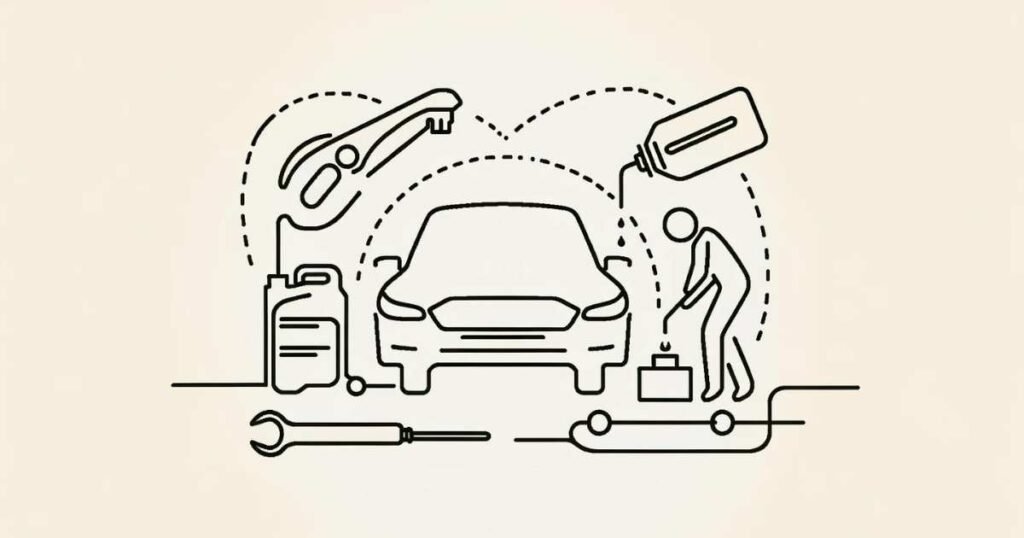Engine oil and the process of changing it are essential parts of taking care of your car. These two things are connected but mean different things about keeping your car running well.
Think of engine oil as the lifeblood of your car’s engine. It’s a special kind of oil that helps to reduce friction. This means it stops the moving parts inside the engine from rubbing against each other too much. Doing this prevents wear and tear and helps the engine work its best.
An oil change is when you take out the old engine oil that has been used and replace it with new, clean oil. This is a really important step because as the engine oil gets older, it also doesn’t work. It can get dirty and stop being as slippery, which is not suitable for the engine. Changing the oil regularly keeps the engine healthy and helps it last longer.
Let’s delve into these questions and explore the key aspects of this main question: “Is Engine Oil the Same as Oil Change?”.
Table of Contents
What is Engine Oil? The Lifeblood of Your Engine
Engine oil is a special oil that helps keep your car’s engine running smoothly. Imagine your car’s engine has many moving parts, and they all need to move without rubbing against each other too much. Engine oil is there to help with this. It’s like a slippery layer that allows the parts to move freely, which stops them from wearing out quickly and getting too hot.
But engine oil isn’t just a straightforward thing. It’s made from a mix of different oils, called base oils, and some extra ingredients called additives. The base oils can come from natural sources like petroleum or can be made by scientists in a lab.
These oils make sure everything stays slippery and moving quickly. The additives do extra jobs like ensuring the oil stays good at hot and cold temperatures, stopping the engine parts from rusting, and helping the oil last longer before changing.
You might hear about two main engine oil types: conventional and synthetic. Conventional oil is the traditional type that has been used for a long time. On the other hand, synthetic oil is made by scientists and has some unique benefits.
It’s good at working in hot or cold temperatures, and you don’t have to change it as often as conventional oil.
So, when you think about engine oil, remember it’s not just one thing. It’s a unique mix that helps your car’s engine stay healthy and work well, whether hot or cold outside.

What are Oil Changes? Maintaining Engine Health
An oil change is like giving your car a fresh start. It’s when you remove all the old oil from your car’s engine and add new oil and a new oil filter. This is important for your vehicle because, over time, the oil in the engine doesn’t work as well anymore.
It gets less effective because of the heat from the engine, rubbing against engine parts, and getting dirty from things like dust and tiny bits of metal.
Having regular oil changes is like making sure your car stays healthy. When you put in fresh oil, it does a few important things:
- It keeps everything running smoothly: New oil ensures the engine parts can move quickly without rubbing against each other too much. This helps to prevent damage to the engine.
- It stops the engine from getting too hot: Oil takes heat away from the engine. If the oil is old, it might not do this as well, and the motor could overheat.
- It keeps the engine clean: The oil filter catches dirt and other stuff that could hurt the engine. When you change the oil, you also get a new filter, so your engine stays cleaner.
How often you should change your oil can be different for every car. It depends on what kind of oil you use, how you drive, and what the car’s manufacturer suggests. It’s a good idea to look in your car’s owner’s manual to find out what they recommend for oil changes.
What are the Key Differences Between Engine Oil Top Off vs. Oil Change?
Caring for a car’s engine involves two key oil-related actions: adding more oil (engine oil top off) and completely changing the oil (oil change). Both play different roles in maintaining the engine.
The process of an “engine oil top off” is straightforward. In your engine, there’s a place called the crankcase where oil is stored. If the oil level in this area drops, perhaps due to burning off or leaking, then more oil is added to the existing amount. This process doesn’t involve removing the old oil; new oil is mixed in to ensure the engine has a sufficient oil level for efficient operation.
On the other hand, an “oil change” is a more thorough approach. It’s like giving the engine a new lease on life. This involves three critical steps:
- Removing all the old oil from the crankcase. Over time, oil deteriorates and loses its effectiveness.
- Switching out the oil filter. This filter is essential as it captures dirt and other unwanted particles from the oil.
- Refilling the engine with fresh, clean oil. This new oil is vital for the smooth and healthy functioning of the engine.
An “engine oil top off” adds more oil to the existing amount, whereas an “oil change” is a complete renewal, replacing old oil with new in the engine.

When to Opt for Each?
When you notice that the oil level is low, topping off oil in a car is a quick fix. Add a little water to a nearly empty water bottle to make it last longer. However, this is only a short-term solution, and it’s essential to understand why.
When you add more oil without changing it, you need to solve the problem of why the oil level got low in the first place. Also, you need to eliminate the old, dirty oil that is already there. Think of it as adding fresh water to a dirty puddle – it doesn’t clean it up.
If you keep adding new oil to the old one, it can cause some issues. For one, the new oil, which is supposed to be clean and efficient, gets mixed with the old, dirty oil. This can make the new oil not work as well as it should. Also, the dirty oil can get thicker and stickier over time, turning into sludge. This sludge can harm the engine and heart of your car and stop it from working properly.
That’s why an oil change is significant. The old, contaminated oil is completely removed when you get an oil change. This is good for your engine because it needs clean oil to work smoothly, stay cool, and keep itself clean.
Also, during an oil change, the oil filter is replaced. The oil filter is like a net that catches dirt or bits that shouldn’t be in the oil. A new filter means your engine is better protected from these unwanted bits.
Checking Your Oil Level and Knowing When an Oil Change Is Due
To ensure your car is running smoothly, checking the oil level and knowing when to change it is essential. Checking the oil level is something you can do yourself, and it’s pretty easy. Most cars have a tool called a dipstick for this job. You can learn how to use it by looking at your car’s owner’s manual. The manual will tell you the steps to check the oil level properly.
Now, knowing when to change the oil is also essential. The best way to find out is to look at your car’s owner’s manual again. This book is helpful because it gives you specific advice based on what kind of car you have, how old it is, and how you use it.
Generally, most cars need an oil change every 3,000 to 5,000 miles. But remember, each vehicle is different, so checking your manual is always good. This way, you can keep your car happy and healthy!
Oil Change vs. Oil Service: What’s the Difference?
Discussing car maintenance often involves “oil change” and “oil service.” Though they seem similar, there are distinct differences between them.
An oil change involves replacing your vehicle’s old engine oil and oil filter with new ones. This process is akin to refreshing your car with new lifeblood, which is vital for keeping the engine functioning smoothly and avoiding wear. During an oil change, mechanics remove the old oil, introduce new oil suitable for your vehicle, and replace the oil filter.
Oil service, on the other hand, extends beyond a mere oil change. Typically provided by car dealerships, this service encompasses everything included in an oil change but adds a thorough examination of your vehicle. This check-up covers various aspects:
- Fluid Levels: This involves verifying the adequacy and condition of essential fluids like brake fluid, coolant, and power steering fluid.
- Tire Pressure and Tread: Correct tire pressure is crucial for safety and fuel efficiency. The service includes assessing the tire pressure and examining the wear on the tire treads.
- Air Filters: Clogged air filters can hinder your engine’s performance. Therefore, their condition is evaluated to determine if cleaning or replacement is necessary.
- Other Components: Additionally, mechanics inspect belts, hoses, and other elements in the engine area to identify any signs of wear or potential issues.
To sum up, while an oil change constitutes an essential vehicle maintenance procedure, an oil service provides a more comprehensive health assessment. It covers the oil change while ensuring all critical components of your car are in optimal condition.
What are the Signs You Need an Oil Change, not a Top-Off?
While topping off might seem like a temporary solution for a low oil level, it shouldn’t become a habit. Here are some signs your car needs a full oil change:
- Frequent top-offs: If you need to top off your oil often, it suggests an underlying issue like an oil leak or excessive oil burning. A full oil change can help diagnose the problem and prevent further damage.
- Oil condition: Healthy engine oil is typically amber-colored. If your oil appears dark brown or black or has a strange odor (like gasoline), it’s time for an oil change.
- Manufacturer’s recommendations: Every car has a recommended oil change interval specified in the owner’s manual. Following this schedule ensures your engine receives clean oil regularly for optimal performance.
How do you check the oil level and Add oil (if necessary)?
When determining whether your car needs just a bit more oil or a full oil change, the initial step is assessing your current oil quantity. Here’s an easy method to do this:
- First, confirm your engine is excellent. Checking the oil with a fantastic engine is ideal.
- Open your car’s hood and search for the oil dipstick. This could be challenging, so if you need help locating it, your owner’s manual can guide you.
- After locating the dipstick, pull it out, but hold off on checking the oil level immediately. First, wipe it off with a lint-free cloth.
- Reinsert the dipstick completely, then remove it again. Now, you can examine the end of the dipstick to see the oil level. The dipstick has marks that indicate the correct level. If the oil is below the minimum mark, it indicates your car needs additional oil.
However, there’s an important point to note! Simply topping off your car’s oil is a temporary measure. It’s different from getting an entire oil change, which is crucial for your car’s health. If you need to add oil, here’s how to do it safely:
- Use the oil type and viscosity that your car’s manual suggests.
- Switch off your engine and allow it to cool before proceeding.
- Locate the oil filler cap (different from the dipstick) and remove it. Gradually add oil, bit by bit.
- Continuously check the oil level with the dipstick to avoid overfilling. Excess oil can be harmful to your car.
- Firmly replace the oil filler cap when the dipstick indicates the appropriate oil level.
Keep in mind that topping off oil is a stopgap solution. Regular oil changes are essential for your car to function well and prevent serious engine issues and costly future repairs.
Final Thoughts
Keeping your car in good shape is essential; changing the engine oil regularly is a big part. The right time to change the oil depends on your car’s type, model, and how you drive. You can find the best schedule for oil changes in your car’s manual or by asking a service center you trust.
Regular oil changes help your car run smoothly, use less gas, and save money. Remember, like you need to drink water, your car needs fresh oil to stay healthy!
Relevant:
Is It Cheaper to Change Your Own Oil?
How Much Oil Do I Need for An Oil Change?
What Percentage Should You Change Your Oil?
How Many Miles to Change Transmission Oil?
How Do I Know If I Need an Oil Change? 10 Major Signs
FAQs
Are engine and motor the same thing?
No, they are not precisely the same. An engine is a machine that turns energy, like fuel, into mechanical work. On the other hand, a motor usually uses electricity to generate power. So, while people sometimes use these words similarly, they have different meanings.
Is Engine Oil the Same as Oil Change?
An oil change is when you drain the old engine oil from your car and put in new oil. This is a common thing that auto repair shops do. But an oil change service is more than just changing the oil. It often includes checking and changing the oil filter and looking at the tires, brake pads, and other fluid levels. This kind of service usually costs more because it checks more things.
Are gear oil and engine oil interchangeable?
No, they are not. Even though they are made from similar oils and additives, they are made for different things. Engine oil is made to lubricate the parts inside an engine. Gear oil is made for gearboxes and differentials. It helps reduce wear and protects against strong forces. Using the wrong oil can cause problems and might even damage your car.
Can I top off my engine oil instead of getting an oil change?
Adding oil occasionally to maintain an appropriate level is acceptable, but it’s not a substitute for a complete oil change. Regular oil changes are necessary to remove contaminants and ensure proper engine lubrication.
Is Engine Oil Just an Oil Change?
No, engine oil and an oil change are different. Engine oil is a lubricant specifically for car engines, helping reduce friction and cool the engine. An oil change is replacing old engine oil with new oil and changing the oil filter. So, they are related but not the same.
Is There a Difference Between Oil and Engine Oil?
Yes, there’s a difference. While “oil” can refer to many types, engine oil is specifically designed for car engines that withstand high temperatures and pressure. Other oils, like cooking oil, are not suitable for engines. Even though people might use the terms interchangeably, they are technically different.
Is Adding Engine Oil the Same as an Oil Change?
No, they are not the same. Adding engine oil, or topping off, means adding more oil to your car’s engine. An oil change means completely removing and replacing the old oil with new oil, including a new oil filter. Topping off is a temporary fix, while an oil change is a more thorough maintenance process.
Does Low Engine Oil Mean I Need an Oil Change?
Only sometimes. Low engine oil can be due to an oil leak, oil burning, or just nearing the time for a routine oil change. It’s essential to understand why the oil is low – it could be a simple reminder for an oil change or an indication of a more significant issue. Consulting the car’s manual or a mechanic is advisable for the right action.
Can I use motor oil instead of engine oil?
Yes, you can. Motor oil and engine oil are the same things. But it’s very important to check your car’s manual to know the right type and thickness of oil for your car.
What are the different types of motor oil?
There are four main types:
1. Synthetic oil: This is made in labs and is good at working in very hot or very cold temperatures. It doesn’t break down as quickly as other oils.
2. Synthetic blend oil: This mix of synthetic and regular oils. It gives you some benefits of synthetic oil but at a lower cost.
3. High mileage oil: This is for cars driven a lot. It has extraordinary things to help reduce leaks and wear on the seals.
4. Conventional oil (mineral oil): This comes from petroleum and is less expensive. But it might not protect your car or work as well as synthetic oils.
Knowing the differences between these oils and choosing the right one for your car is very important to keep your engine running well for a long time.


